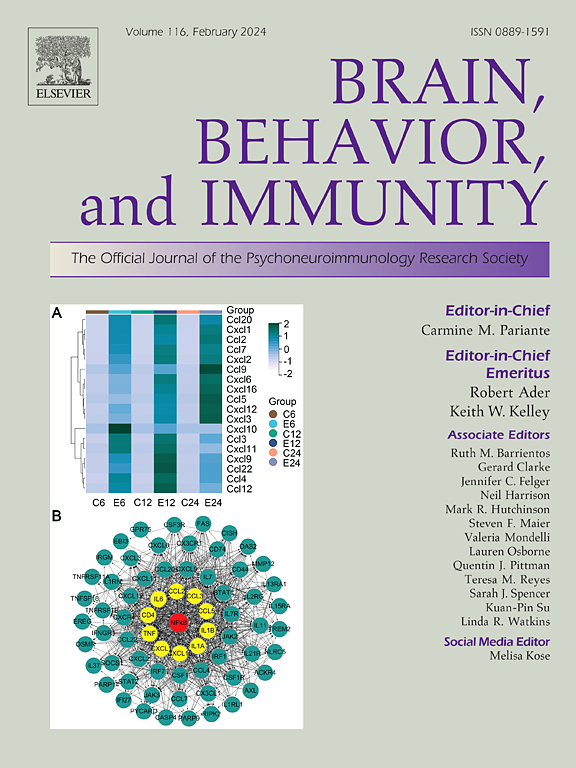Pathogen-specific exposure is associated with multisite chronic pain: A prospective cohort study
IF 8.8
2区 医学
Q1 IMMUNOLOGY
引用次数: 0
Abstract
Evidence suggests that pathogens may influence pain perception and regulation; however, no study has explored the relationship between serological evidence of infection and multisite chronic musculoskeletal pain. Therefore, this study aimed to investigate the association between serological evidence of infection and multisite chronic musculoskeletal pain. Participants (n = 6,814; mean [SD]age, 56.5[8.2] years; females [52.9 %]) in the UK Biobank were included. Multiplex serology panel measuring serum immunoglobulin G antibody levels against 20 infectious agents was performed at baseline. Chronic pain (≥3 months) in the knee, neck/shoulder, hip, back, or ‘all over the body’ was assessed at baseline and follow-up. Participants were grouped by number of chronic pain sites: no chronic pain, chronic pain in 1–2 sites, or ≥3 sites. Multinomial logistic regression and mixed-effect multinomial logistic regression models were used for the analyses. The seroprevalences of serologically detected infections across the 20 agents ranged from 0.2 % to 95.4 %. In multivariable analyses, serological evidence of infection with Epstein-Barr Virus (EBV), Human T-Cell Lymphotropic Virus Type-1 (HTLV-1), and Chlamydia Trachomatis was cross-sectionally associated with chronic pain in ≥3 sites compared to those without chronic pain. In longitudinal analyses, EBV [relative risk ratio (RRR) = 2.18, 95 %CI:1.17 − 4.05] and Chlamydia Trachomatis [RRR = 1.38, 95 %CI:1.09 − 1.74] were also associated with chronic pain in ≥3 sites. Additionally, serological evidence of single and multiple infections was associated with chronic pain in ≥3 sites, but not in 1–2 sites. Collectively, serological evidence of infection with EBV and Chlamydia Trachomatis is associated with multisite chronic musculoskeletal pain. These findings suggest that infectious agents may play a role in the pathogenesis of widespread chronic pain.
病原体特异性暴露与多部位慢性疼痛相关:一项前瞻性队列研究
有证据表明,病原体可能影响疼痛感知和调节;然而,没有研究探讨血清学证据的感染和多部位慢性肌肉骨骼疼痛之间的关系。因此,本研究旨在探讨感染的血清学证据与多部位慢性肌肉骨骼疼痛之间的关系。参与者(n = 6,814;平均[SD]年龄56.5[8.2]岁;包括英国生物银行(UK Biobank)的女性[52.9%]。在基线时进行多重血清学检测血清免疫球蛋白G抗体水平。在基线和随访时评估膝关节、颈/肩、髋关节、背部或“全身”的慢性疼痛(≥3个月)。根据慢性疼痛部位的数量对参与者进行分组:无慢性疼痛、1-2处慢性疼痛或≥3处慢性疼痛。采用多项logistic回归和混合效应多项logistic回归模型进行分析。20种药物的血清学检测感染的血清患病率从0.2%到95.4%不等。在多变量分析中,与没有慢性疼痛的患者相比,感染eb病毒(EBV)、人t细胞嗜淋巴病毒1型(HTLV-1)和沙眼衣原体的血清学证据与慢性疼痛在≥3个部位呈横断面相关性。在纵向分析中,EBV[相对风险比(RRR) = 2.18, 95% CI:1.17 ~ 4.05]和沙眼衣原体[RRR = 1.38, 95% CI:1.09 ~ 1.74]也与≥3个部位的慢性疼痛相关。此外,血清学证据表明,单次和多次感染与≥3个部位的慢性疼痛相关,但与1-2个部位无关。总的来说,EBV和沙眼衣原体感染的血清学证据与多部位慢性肌肉骨骼疼痛有关。这些发现表明,传染因子可能在广泛的慢性疼痛的发病机制中起作用。
本文章由计算机程序翻译,如有差异,请以英文原文为准。
求助全文
约1分钟内获得全文
求助全文
来源期刊
CiteScore
29.60
自引率
2.00%
发文量
290
审稿时长
28 days
期刊介绍:
Established in 1987, Brain, Behavior, and Immunity proudly serves as the official journal of the Psychoneuroimmunology Research Society (PNIRS). This pioneering journal is dedicated to publishing peer-reviewed basic, experimental, and clinical studies that explore the intricate interactions among behavioral, neural, endocrine, and immune systems in both humans and animals.
As an international and interdisciplinary platform, Brain, Behavior, and Immunity focuses on original research spanning neuroscience, immunology, integrative physiology, behavioral biology, psychiatry, psychology, and clinical medicine. The journal is inclusive of research conducted at various levels, including molecular, cellular, social, and whole organism perspectives. With a commitment to efficiency, the journal facilitates online submission and review, ensuring timely publication of experimental results. Manuscripts typically undergo peer review and are returned to authors within 30 days of submission. It's worth noting that Brain, Behavior, and Immunity, published eight times a year, does not impose submission fees or page charges, fostering an open and accessible platform for scientific discourse.

 求助内容:
求助内容: 应助结果提醒方式:
应助结果提醒方式:


